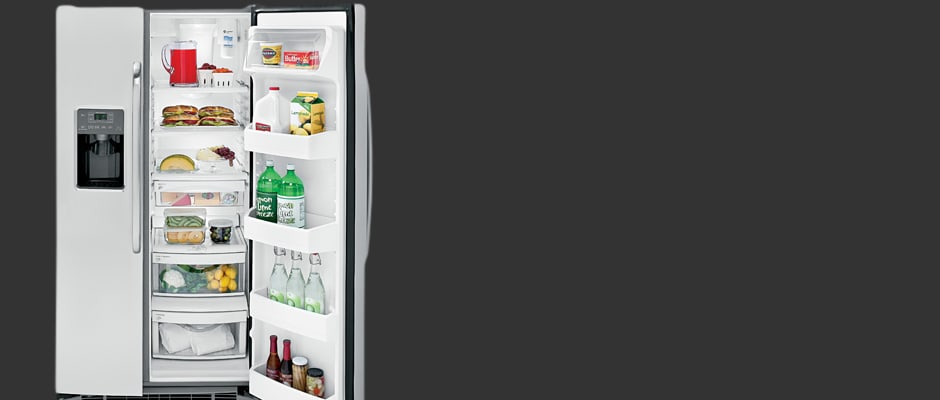Pros
Cons
Introduction
Design & Usability
{{section_header}}{{section.name}}{{/section_header}}
An approachable fridge with few complicated features, easy-to-read controls, and clearly labeled drawers
This GE has a stainless steel finish with a through-the-door water and ice dispenser located on the left door. The interior looks clean and organized, with specifically labeled drawers. From top to bottom, they are called the “Snack Pan,” “Fruits & Vegetables,” and “Sealed Pan.” The freezer has a rather large ice maker located at the very top of the compartment, with wire shelves laid out in a traditional manner for a side-by-side.
Moving back to the exterior, the control panel is set above the water dispenser on the freezer door. Fridge and freezer temperatures can be adjusted separately, and are measured in degrees Fahrenheit. There are two buttons to raise and lower the temperatures, complete with a manufacturer’s recommended setting. The controls are easy enough to use, but could have been more streamlined. Temperature controls that are measured using an actual degree scale instead of an arbitrary “cold to colder” dial are refreshing, offering greater temperature accuracy for both sides. However, having separate buttons for different ice types makes it seem just a tad cluttered.
{{photo_gallery "Front Photo", "Fingerprints Photo", "Handle Photo", "Handle Detail Photo", "Water/Ice Dispenser Photo", "Water/Ice Dispenser Controls Photo", "Water/Ice Dispenser Detail Photo", "Interior Photo", "Refrigerator Main 1 Image", "Refrigerator Main 2 Image", "Refrigerator Main 3 Image", "Water Filter Photo", "Refrigerator Door 1-1 Image", "Refrigerator Door 1-2 Image", "Refrigerator Door 1-3 Image", "Refrigerator Door 2-1 Image", "Refrigerator Door 2-2 Image", "Refrigerator Door 2-3 Image", "Freezer Main 1 Image", "Freezer Main 2 Image", "Freezer Main 3 Image", "Freezer Door 1 Image", "Freezer Door 2 Image", "Freezer Door 3 Image", "Ice Maker Photo", "Back Photo", "Back Detail Photo", "Sides Photo", "Side Detail 1 Photo", "Side Detail 2 Photo", "Fridge Temperature Image", "Freezer Temperature Image", "Vegetable Drawer Photo", "Vegetable Drawer Controls Photo", "Ease of Access Photo", "Controls Photo", "Cleaning Photo", "Other Features Photo"}}
Features
{{section_header}}{{section.name}}{{/section_header}}
A high level of accessibility are countered by somewhat poor shelf stability and sticky drawers.
The good news? The shelves are wide and deep enough to offer easy access to nearly any location inside the GE. The bad news? With the exception of the “Fruits & Vegetables” tray, all the drawers, including the freezer basket, can stick when being moved in or out. In an unusual design choice, the shelves are held in place with what best can be described as little plastic snags. They keep the shelves from being yanked out of the fridge, but they're difficult to depress, meaning shelf adjustment can be a pain.
The water dispenser, like many through-the-door designs, is very straightforward: You push on a paddle and water comes out. There are two small issues with GE's take on this familiar approach, however. The paddle’s curved design is meant to fit the shape of an average water glass, but if you want to fill something that is larger than the curve, you may have some trouble. Also, the paddle doesn’t even extend halfway into the cavity, meaning smaller glasses may have to be held the whole time. The actual ice maker is located at the very top of the freezer, and its large size makes it a bit unwieldy. GE took this into account, however, and has placed a doggie-door style flap to allow access to bulk ice without having to pull out the whole thing.
Performance
{{section_header}}{{section.name}}{{/section_header}}
A poor freezer detracts from the positive attributes provided by the fridge’s vegetable drawer.
The GE’s temperature was fairly consistent over time, but there was a definite change from top to bottom. Though we adjusted the fridge to the manufacturer’s calibration and the fridge’s own temperature display said 37 degrees, it still ran a bit warmer at the top than is ideal. At the very least, the bottom ran closer to the listed temperature. This can be adjusted by bringing the temperature down a notch.
Over the three day testing period, the temperature in the GE’s freezer fluctuated a very large amount. While food was always frozen, the temperature fluctuated noticeably, with the top of the freezer running warmer than is ideal. Freezer burn is much more likely to occur under such conditions, and you may find yourself throwing out a lot of food because of it.
We should note that moisture retention in the vegetable drawer was above par—a surprise given the other issues we had with this model. Fresh produce should remain crisp and delicious just a bit longer than average, meaning you can go to the store without having to worry about throwing anything out... unless, of course, you buy the entire wooden box of lettuce.
Conclusion
{{section_header}}{{section.name}}{{/section_header}}
A decent fridge that is marred by some performance issues
The GE GSHS6HGDSS isn’t a bad fridge—it just isn’t as good as a lot of other models that are available, both in terms of size and performance. With an MRSP of $1,399, a consumer should get a fridge that will preserve and protect any food stored in it; issues with temperature shifts mean this model won't necessarily do as good a job as some other products we've tested. This GE did have a great vegetable drawer that minimized moisture loss, though, a perk for salad lovers. If you can find it on sale it wouldn't be a bad purchase, as long as you do at least some comparison shopping first.
Science Introduction
{{section_header}}{{section.name}}{{/section_header}}
With somewhat questionable temperature consistency, you may find yourself throwing out more food than you should. Take a look at the numbers to see exactly what issues we had with the GE.
Temperature Performance
{{section_header}}{{section.name}}{{/section_header}}
The fridge is merely acceptable; the freezer is downright disappointing.
The internal temperature of food in this fridge generally came out to be a degree or so warmer than what the thermostat indicated. Throw in some additional temperature shift from top to bottom—though only minimal fluctuation—and you'll want to turn the temperature down a bit lower than you otherwise might.
The freezer exhibited about a six degree shift from top to bottom, going from about 0.2 degrees Fahrenheit—roughly the ideal temperature—to a warmer 6 degrees. Fluctuation over time wasn't promising, either, with a 1.5 to 2 degree shift on average. Don't keep anything too long, or you'll be eating more freezer burn than frozen food.
{{photo_gallery "Science Section 1 Images"}}
Moisture Retention
{{section_header}}{{section.name}}{{/section_header}}
A high point in an otherwise mediocre fridge
The GE’s single vegetable drawer yielded consistently positive results for our humidity retention test. Setting the drawer to its highest setting in order to retain the most amount of moisture possible, we see just how quickly something placed here will dry out. Too much moisture lost means produce will wilt and spoil sooner than it should. Losing 0.16 grams per hour of water each day, produce placed in this GE will stay crisp for a longer amount of time than they would in many other fridges of this type.
{{photo_gallery "Science Section 2 Images"}}
Freezing & Thawing
{{section_header}}{{section.name}}{{/section_header}}
Faster-than-average freezing, but it's one of the rare fridges that failed our power loss test.
In an ideal world, food would be flash frozen, preserving all of its freshness and nutritional value. Home freezers aren’t exactly capable of this, but the closer we can get to instantaneous freezing, the better. The GE managed to bring our test material down to freezing from room temperature in 1 hour and 25 minutes. This is pretty good compared to similar fridges—it’s not perfect, but it’ll be good enough to keep your food well-preserved.
That said, the GE only managed to keep food frozen for up to 32 hours after we pulled the plug. As long as you leave the freezer door shut, the internal insulation should be effective enough that food will stay frozen for at least a day and a half, if not more. If you have this fridge and lose power, hope that your electric company gets things up and running, otherwise you’ll be putting a lot of food out on garbage day.
{{photo_gallery "Science Section 3 Images"}}
Storage Space & Energy Efficiency
{{section_header}}{{section.name}}{{/section_header}}
The storage space capacity is on par with most side-by-sides.
Our numbers are always lower than those produced by the manufacturer because we subtract space taken up by shelves and light fixtures from the overall capacity of the interior. As such, even though this is marketed as being a 25.9 cubic foot fridge, we found that there was really just 14.59 cubic feet of actual space: 9.85 cubic feet in the fridge, with another 4.74 in the freezer.
The amount of energy used by the GE for a year, using a standard rate of $0.09 per kWh, came out to $68.40. By comparing the overall energy consumption with respect to storage space, we can also determine that it uses just 0.14 kWh per cubic foot. That makes it a fairly efficient model, even though the objective bill may be rather hefty.
{{photo_gallery "Science Section 4 Images"}}
Other Tests
{{section_header}}{{section.name}}{{/section_header}}
{{photo_gallery "Other Tests Images"}}
Meet the tester
Matthew is a native of Brockton, MA and a graduate of Northeastern, where he earned a degree in English and Theatre. He has also studied at the Gaiety School of Acting in Dublin and spends most of his free time pursuing a performance career in the greater Boston area.
Checking our work.
Our team is here to help you buy the best stuff and love what you own. Our writers, editors, and experts obsess over the products we cover to make sure you're confident and satisfied. Have a different opinion about something we recommend? Email us and we'll compare notes.
Shoot us an email

